Listen to This Article:
Imagine a warm, savory wrap embracing layers of ham, melted cheese, and a perfectly cooked egg—simple yet completely satisfying. Or a delicate fold filled with marinated grilled chicken, spinach, pesto, and juicy tomatoes. And for dessert, a sweet indulgence of rich Nutella, sweet bananas, and ripe strawberries, finished with a dusting of powdered sugar. What do all these dishes have in common? They’re crêpes!
This French culinary classic is one of the most versatile foods, transitioning from savory to sweet and from breakfast to dinner to dessert. Whether served as street food or plated in fine-dining style, crêpes have earned their place as a global favorite.
In this guide, we’ll explore the ins and outs of crêpes: their history, the tools and techniques to make them, and the many ways to enjoy these paper-thin pancakes.
What is a Crêpe?
In their basic form, crêpes are simple. They are nothing more than a thin, delicate French pancake. Similar to pancakes, they are generally made from a batter of flour, eggs, milk, and butter. However, what can be done with crêpes is what makes them special.
Like pancakes, crêpes can be stacked and topped with a variety of sweet fillings. You may find fresh fruit, a drizzle of chocolate, or a dusting of powdered sugar on top of a stack of crêpes.
But unlike pancakes, you can also find crêpes that are folded and filled with all different kinds of savory or sweet ingredients. For example, you may find a crêpe stuffed with marinated chicken, slices of tomatoes, fresh spinach, and a creamy garlic sauce. Or, you may find a crêpe layered with a chocolate hazelnut spread and folded around fresh fruit.
This brings us to another amazing thing about crêpes—they can be served any time of day. You may enjoy them for breakfast, dinner, or even dessert. Only your imagination and creativity limit what you do with a crêpe.
How Are Crêpes Different from Pancakes?
Crêpes are thinner, lighter, and more delicate than pancakes, which makes them suitable for sweet and savory dishes alike. Unlike pancakes, crêpes don’t use baking powder or other rising agents, which gives them their signature flat and smooth texture.
The History and Cultural Significance of Crêpes
Crêpes first made their way onto the culinary scene around the 13th century in Brittany, a region of northwest France. Known as galettes, which is French for pancakes, they were typically made with buckwheat and filled with savory ingredients like egg, cheese, and ham.
In the 19th century, wheat flour began replacing the use of buckwheat in the recipe, and crêpes transformed into what we know today. This was also the beginning of the popularity of sweet crêpes. Over the years, crêpes continued to grow in popularity and even became connected with a French holiday.
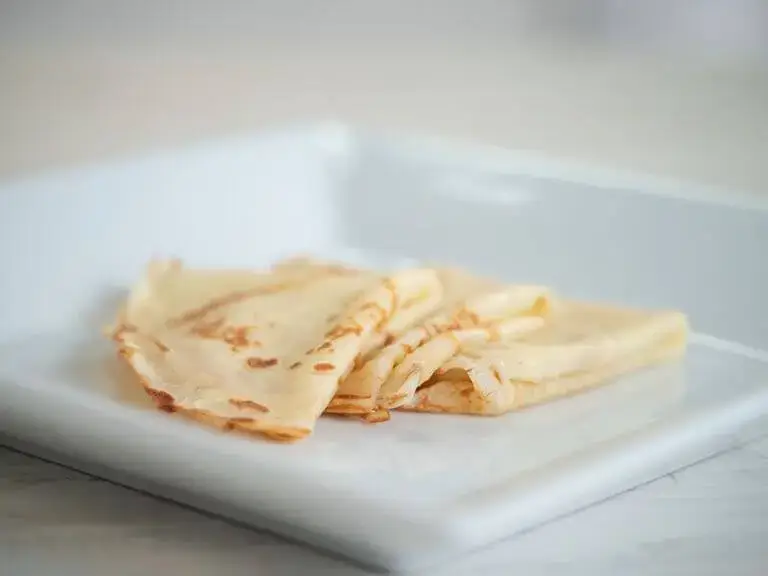
Crêpes are thinner, lighter, and more delicate than pancakes.
An Annual Celebration of Crêpes
La Fête des Chandelles or Crêpe Day is celebrated annually on Feb. 2 and has historically been associated with different purposes, including:
- A day to celebrate Faunus, the Roman god of agriculture
- A day marking the middle of winter
- A Christian holiday called the Feast of the Presentation of Jesus in temple
- A Catholic church holiday called Candlemas, so named because of the tradition of blessing and distributing candles
Whatever the origin of the holiday, crêpes are to Feb. 2 what King Cakes are to Mardi Gras. And just like people hide a plastic baby in a King Cake, some people cook a coin into their crêpes and whoever finds it has good luck for the year.
While La Chandeleur highlights crêpes on a single day, their appeal to the world extends far beyond that. The rustic galettes of the past, refined and elevated over the years, are celebrated around the world every day.
Crêpes Today: From Street Vendors to Refined Elegance
If you find yourself in Brittany today, you can still stumble upon traditional crêperies that serve galettes with cider. Or if you find yourself walking the streets in Paris, you may notice street vendors serving made fresh to order crêpes served with sweet fillings like Nutella and bananas.
But the evolution of the dish doesn’t stop there.
In fine dining restaurants, you may see a dessert on the menu called Crêpes Suzette. The crêpes are flambéed in a sauce made from freshly squeezed orange juice, zest, sugar, and butter, often with a splash of orange liqueur such as Grand Marnier or Cointreau. The flambéing process caramelizes the sauce, enhancing its vibrant citrus flavor while creating a dramatic table-side presentation.
But whether you’re drawn to their rustic charm or refined elegance, the good news is that making crêpes at home is easier than you might think.
How to Make Crêpes
With a simple batter and a few basic techniques, you can create thin, delicate crêpes that rival those served in a French café right from your home kitchen.
Tools and Equipment for Making Crêpes
- Non-stick crêpe pan or seasoned cast iron pan (or a crepe maker)
- T-spreader (or spatula) for even batter distribution
- Ladle for precise batter portions
- Thin spatula for flipping crêpes
- Whisk or blender for smooth batter preparation
Step-by-Step Instructions for Easy Crepes
Here is a basic recipe for crêpes that yields 4 servings
Ingredients
- 250g All Purpose Flour
- 31g Sugar
- 8g Salt
- 188g Eggs
- 500g Whole Milk
- 50g Oil or Clarified Butter
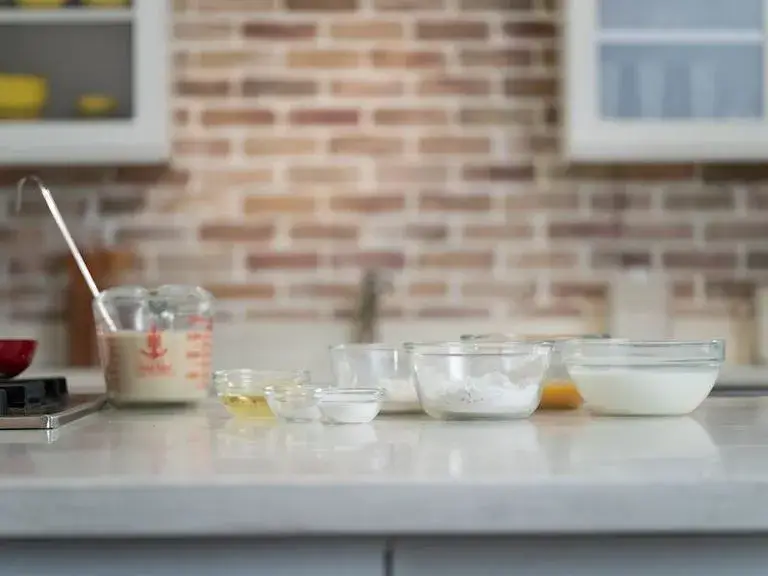
You can make crêpes at home with a little prep and a simple batter.
Method
- Sift the flour, sugar, and salt into a bowl.
- Add the eggs and just enough of the milk to make a soft paste with the flour, mix until lump free.
- Slowly add the rest of the milk and oil. The batter should be the consistency of heavy cream. If it is too thick, thin batter with a little water. If it’s lumpy, strain it.
- Let the batter rest for at least 2 hours or overnight.
- Brush a 6-8” non stick pan lightly with oil or butter and heat over medium until hot.
- Remove from the heat and pour in 3-4 tbsp. of batter and quickly swirl the pan to cover the bottom with a thin layer of batter.
- Return to the heat for about 1-1.5 minutes until the bottom is lightly browned.
- Flip crepe and brown on the other side.
Troubleshooting Common Mistakes
Any cook can encounter challenges when making crêpes. Here’s how to overcome some common issues to achieve perfectly thin and delicate crêpes:
Crêpes too thick? Use minimal batter to achieve thin crêpes. Pour a small amount into the pan, swirling quickly for an even spread. If the batter is too thick, add a little milk to thin it out.
Crêpes tearing easily? Try letting the batter rest longer to improve the elasticity. Also ensure the pan is properly greased to prevent sticking.
Crêpes have an uneven texture? To achieve a smoother consistency, try whisking the batter thoroughly to remove any lumps. You can also use a blender to achieve an even mixture.
With practice and keeping these tips in mind, you can turn out consistent crêpes in no time!
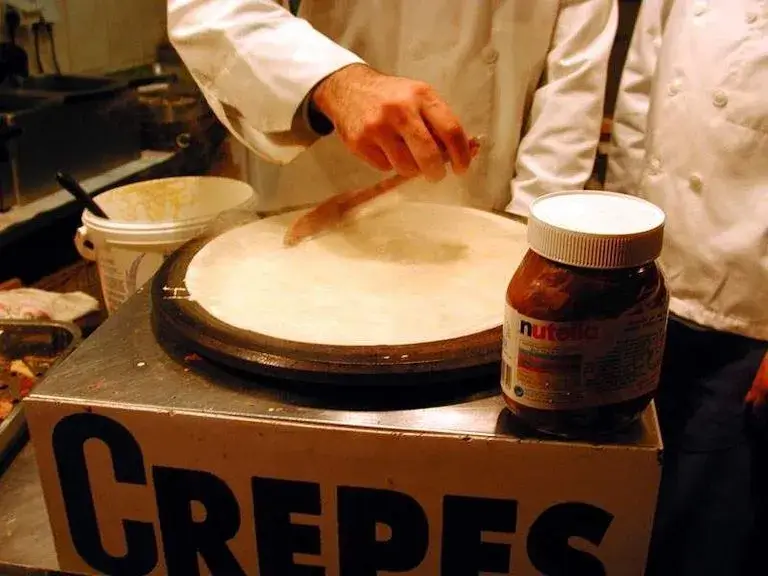
Crêpes require some attention to detail but can make for a fun and elegant meal or dessert.
Types and Variations of Crêpes
Whether you’re savoring a classic French galette or looking for a more modern twist, there’s a crêpe for every occasion and taste.
Sweet Crêpes
Sweet crêpes, made with white wheat flour and a touch of sugar, are light, delicate, and perfect for dessert or breakfast.
Classic Fillings:
- Lemon and Sugar: A traditional choice, offering a balance of tart and sweet flavors.
- Nutella and Bananas: A rich, indulgent favorite that’s loved worldwide.
- Fresh Fruit and Cream: Strawberries, raspberries, or blueberries with whipped cream or mascarpone.
Modern Twists:
- Salted Caramel and Pecans: A decadent pairing of sweet and salty with a satisfying crunch.
- Coconut Cream and Mango: A tropical twist with creamy coconut and juicy mango slices.
- Lavender Lemon Curd: Add a floral and tangy element for a sophisticated dessert option.
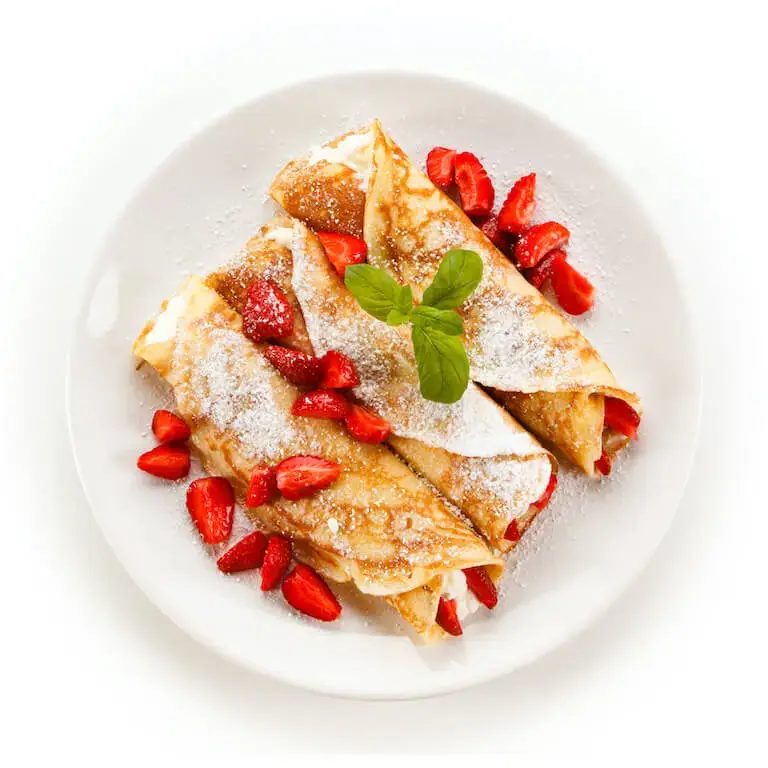
Sweet crêpes are a delicious choice for breakfast or dessert alike.
Savory Crêpes (Galettes)
Savory crêpes, traditionally made with buckwheat flour, are earthy, hearty, and naturally gluten-free. They are typically served as a main dish as opposed to a dessert.
Classic Fillings:
- Ham, Cheese, and Egg: The iconic Breton combination, often called La Complète.
- Spinach and Goat Cheese: A vegetarian favorite with a creamy, tangy filling.
- Smoked Salmon and Crème Fraîche: A luxurious option with a touch of dill.
Modern Twists:
- Avocado, Bacon, and Tomato: A fresh take on the BLT, complete with creamy avocado.
- Pulled Pork and Coleslaw: A fusion of classic barbecue and French cuisine.
- Buffalo Chicken and Blue Cheese: A spicy and bold option for fans of zesty combinations.
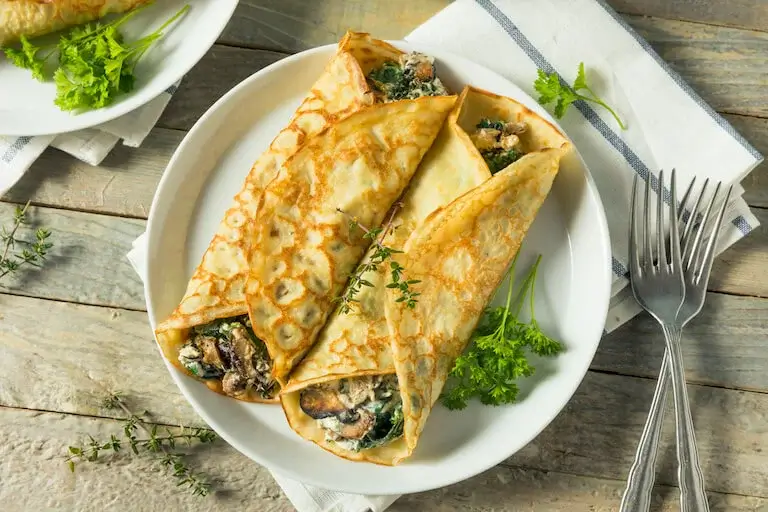
Crêpes work well with a wide variety of savory fillings.
Crêpe Variations Across the Globe
Crêpes have been embraced and reinvented around the world, reflecting local tastes and traditions:
- Japan: Thincrêpes are rolled into cones and filled with whipped cream, custard, fruits, and even savory ingredients like shrimp or avocado.
- Mexico: Crepas con Cajeta are a sweet treat, topped with a caramel-like goat’s milk sauce.
- India: Inspired by crêpes, dosa is a savory version made with fermented rice and lentil batter, often filled with spiced potatoes.
- United States: Crêpe cakes and brunch-worthy crêpes with indulgent toppings have become trendy staples
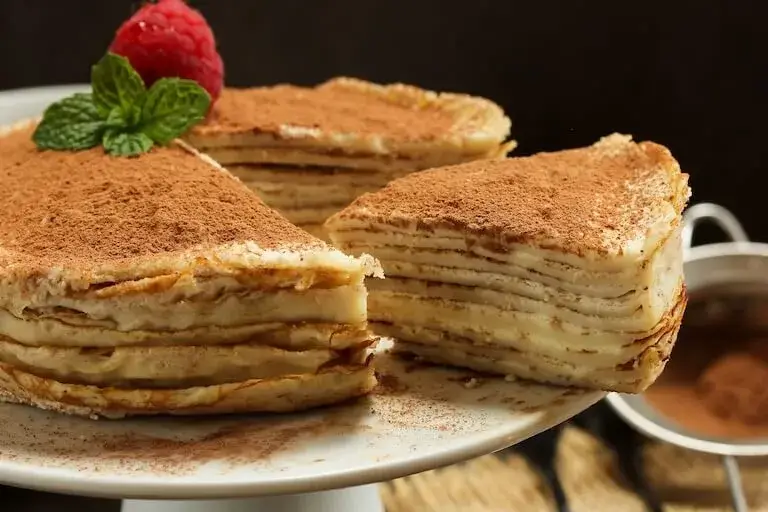
Crêpes aren’t only found in France. Many countries have adapted them to reflect their food cultures.
Street Food vs Fine Dining
The presentation of crêpes typically varies based on where and how you’re eating them. When served as a grab-and-go snack or treat from street vendors, crêpes are generally folded into quarters and filled with simple ingredients like ham and cheese or nutella.
However, when found in upscale restaurants, crêpes are often served rolled or layered into dishes like Crêpes Suzette.
Serving Suggestions and Pairings
The way you serve crêpes can elevate them to fit any occasion. Here are some ideas to inspire your next crêpe experience:
Sweet Crêpe Pairings
Beverages: Pair with coffee, tea, or dessert wine like Sauternes or Moscato.
Toppings: Enhance flavors with a drizzle of chocolate, a scoop of vanilla ice cream, or a sprinkle of nuts.
Savory Crêpe Pairings
Beverages: Serve with dry cider (a classic pairing in Brittany), a crisp white wine, or kombucha for a modern twist.
Sides: Complement savory crêpes with a simple green salad, roasted vegetables, or a bowl of soup.
FAQ About Making Crêpes
Can crêpes be made ahead of time?
Absolutely! You can prepare the batter up to 24 hours in advance and store it in the refrigerator. You can also cook crêpes and keep them in the refrigerator with parchment paper in between for 2-3 days. They reheat best on a non-stick pan, but you can also microwave them.
Can I freeze crêpes?
Yes! Stack them with parchment paper between the layers and place the stack in an airtight container or freezer bag in the freezer for up to 2 months. To thaw, leave them in the refrigerator overnight and reheat as needed.
What is the best way to prevent crêpes from sticking to the pan?
A well-preheated, lightly greased non-stick or seasoned cast iron pan is key. Always ensure the pan is hot enough before pouring the batter, and grease it lightly between crêpes. If sticking persists, it might be time to re-season your pan or use a small amount of butter for each crêpe.
Can I make vegan crêpes?
Yes, you can make vegan crêpes! Replace eggs with a flaxseed or chia seed egg (1 tablespoon seeds + 2.5 tablespoons water per egg) and use plant-based milk, such as almond or oat milk. Coconut oil or vegan butter works well for greasing the pan.
Bringing Crêpes to Your Kitchen
Crêpes are a fun and versatile dish that have become a timeless classic around the world. There are endless possibilities on how you can prepare and enjoy crêpes from savory to sweet, breakfast to dessert, and everything in between.
If exploring dishes from around the world excites you, why not take the next step? At Escoffier, our programs can introduce you to global cuisines and provide opportunities to develop both foundational and advanced culinary techniques. From French classics like crêpes to other international flavors, you can discover new ways to grow your skills and passion for food. Contact us to find out more and begin your culinary journey today!

